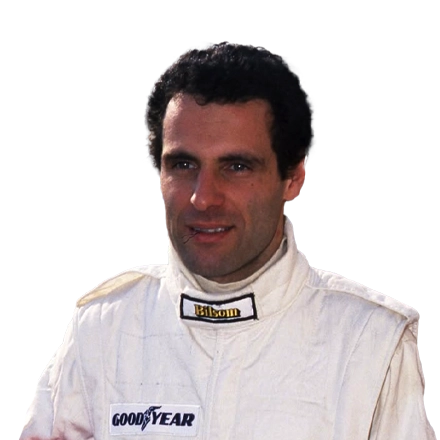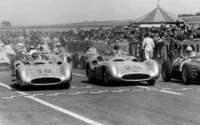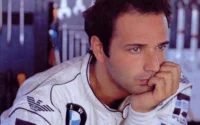Roland Ratzenberger was an Austrian racing driver who competed in three Formula One Grands Prix in 1994. He is remembered for his tragic death during qualifying for the 1994 San Marino Grand Prix at Imola, a crash that, alongside the death of Ayrton Senna a day later, catalysed sweeping safety reforms in Formula One.
| Nationality | Austrian |
|---|---|
| Born | Roland Walter Ratzenberger 4 July 1960 Salzburg, Austria |
Born in Salzburg, Austria, Ratzenberger began racing through the Lechner Racing School at the Salzburgring. He progressed through Formula Ford, winning both national and European titles, as well as the prestigious Formula Ford Festival in 1986.
He split his career between touring cars and single-seaters, finishing third in the 1989 British Formula 3000 Championship and entering the 24 Hours of Le Mans for the first time that year. In the early 1990s, he built a successful career in Japanese motorsport, competing in the World Sportscar Championship, All-Japan Sports Prototype Championship, and Japanese Formula 3000. He won the C2 class at Le Mans in 1993 with SARD and Toyota.
Formula One Career
Simtek: 1994
Ratzenberger achieved his dream of entering Formula One in 1994, signing a five-race deal with the new Simtek team, alongside David Brabham. The seat was secured with help from German sponsor Barbara Behlau.
Making his debut at the 1994 Brazilian Grand Prix, he failed to qualify. His first and only start was at round two for the 1994 Pacific Grand Prix in Aida, where he finished 11th. Ratzenberger had prior experience at the Aida circuit, which aided his performance in the underpowered Simtek S941.
Fatal Crash at Imola
On 30 April 1994, during qualifying for the 1994 San Marino Grand Prix, Ratzenberger was killed after his front wing—damaged on a prior off-track excursion—failed at high speed.
Ratzenberger’s fatal crash happened at the Villeneuve Corner during the second qualifying. Earlier in the session, Ratzenberger had run off track at the Acque Minerali chicane, likely damaging his front wing. Unaware of the extent of the damage, he continued his qualifying run. As he approached the high-speed left-hander of Villeneuve Corner, the weakened front wing failed under load and became lodged under the car, making steering and braking impossible. At this point, Ratzenberger was travelling at nearly 315 km/h (195.7 mph).
The car struck a concrete barrier at full speed, resulting in a devastating impact. The force of the collision caused catastrophic injuries: a basilar skull fracture, a ruptured aorta, and blunt trauma to the head and neck, reportedly from the left front wheel that penetrated the survival cell. The severity of these injuries was such that they were each individually fatal. On-site medical teams responded quickly, and Ratzenberger was airlifted to Bologna’s Maggiore Hospital, where he was pronounced dead shortly after arrival.
Ratzenberger’s death marked a tragic milestone in F1 history—he became the first driver to die during a Grand Prix weekend since Riccardo Paletti in 1982. His passing was deeply overshadowed by the death of Ayrton Senna just one day later, but it was no less significant in shaping the future of motorsport safety. Together, these two tragedies led to a radical overhaul of safety standards in Formula One, beginning with the immediate reformation of the Grand Prix Drivers’ Association and continuing with long-term technical, circuit, and medical reforms that continue to protect drivers to this day.
Reactions and Aftermath
In the immediate aftermath of Roland Ratzenberger’s death during qualifying at Imola, his teammate David Brabham was left devastated. Despite the shock and grief within the Simtek team, Brabham made the difficult decision to race on Sunday in honour of Ratzenberger. He felt a sense of duty to carry on, both for the team and for his fallen colleague, saying later that he wanted to lift the spirits of the crew who had worked so hard under such tragic circumstances. Meanwhile, fellow drivers and teams were grappling with the sobering reality of the first Grand Prix weekend fatality in over a decade.
Upon learning of Ratzenberger’s death, Ayrton Senna rushed to the circuit’s medical centre to confirm the news. Deeply affected, Senna reportedly considered withdrawing from the race altogether. He spoke at length with F1 medical chief Sid Watkins, who suggested Senna stop racing for his own well-being. Despite the warning and his own visible distress, Senna ultimately chose to compete, though he remained emotionally shaken. In a touching gesture of solidarity, Paul Belmondo declined to move into Ratzenberger’s grid position, citing both respect and the belief that he had not earned the spot.
Tragically, the following day’s Grand Prix would end in even further devastation, as Ayrton Senna himself was killed in a crash at the Tamburello corner. Senna’s death understandably dominated headlines and global mourning, often overshadowing Ratzenberger’s own loss. However, it was later revealed that Senna had planned to honour Ratzenberger publicly: he had been carrying a folded Austrian flag in his cockpit, intending to wave it in tribute if he won the race. This small but powerful act showed the depth of Senna’s compassion and the impact Ratzenberger’s death had made on even the sport’s greatest champion.
Funeral and Legacy
In the wake of the Imola tragedy, Roland Ratzenberger’s death received significantly less public attention than that of Ayrton Senna. While all active Formula One drivers attended Senna’s state funeral in São Paulo, only five—David Brabham, Gerhard Berger, Johnny Herbert, Heinz-Harald Frentzen, and Karl Wendlinger—were present at Ratzenberger’s burial in Salzburg. Among the few senior figures who paid their respects was FIA President Max Mosley, who later explained his decision candidly: “Roland had been forgotten. I thought it was important that somebody went to his.”
At the next race in Monaco, Formula One paid tribute to both lost drivers. The first two grid positions were left empty and painted with the Austrian and Brazilian flags, in honour of Ratzenberger and Senna, respectively.
Outside of Formula One, Ratzenberger’s intended participation at Le Mans was also commemorated. He was scheduled to drive the Toyota 94C-V later that year, and in a poignant tribute, the team chose to leave his name on the entry list. His friend Eddie Irvine stepped in to take the seat, but Ratzenberger’s name remained on the car throughout the event.
Safety Reform
Ratzenberger’s fatal crash at Imola was a pivotal moment in the history of Formula One safety. Although his death was overshadowed by Ayrton Senna’s the following day, it was Ratzenberger’s accident that first triggered an immediate and urgent response within the sport. The Grand Prix Drivers’ Association (GPDA), which had been inactive since the early 1980s, was reformed the very next day after Ratzenberger’s crash. Senna, Gerhard Berger, and Michael Schumacher were appointed as its initial directors, tasked with advocating for better driver protection and circuit safety.
This renewed focus on safety led to a series of investigations, track changes, and long-term reforms. The FIA worked closely with teams and medical experts to reduce the risks drivers faced, particularly in high-speed crashes. Improvements were made to cockpit structures, run-off areas, barrier design, and helmet technology in the years following Imola.
Perhaps the most important and lasting change came in 2003, when the FIA made it mandatory for all drivers to wear the HANS (Head and Neck Support) device. This safety device was specifically developed to prevent basilar skull fractures—the very injury that had killed Ratzenberger. Though it arrived nearly a decade later, the HANS device became a standard feature in global motorsport, and its introduction is often directly linked to the loss of Ratzenberger, whose death served as a painful but necessary catalyst for change.
Roland Ratzenberger’s Formula One World Championship career
| Active years | 1994 |
|---|---|
| Teams | Simtek |
| Entries | 3 (1 starts) |
| Championships | 0 |
| Wins | 0 |
| Podiums | 0 |
| Career points | 0 |
| Pole positions | 0 |
| Fastest laps | 0 |
| First entry | 1994 Brazilian Grand Prix |
| Last entry | 1994 San Marino Grand Prix |
Roland Ratzenberger Teammates
| 2 drivers | Involvement | First Year | Last Year |
|---|---|---|---|
| David Brabham | 3 | 1994 |
Roland Ratzenberger Complete Formula One Results
| Year | Entrant | Chassis | Engine | 1 | 2 | 3 | 4 | 5 | 6 | 7 | 8 | 9 | 10 | 11 | 12 | 13 | 14 | 15 | 16 | WDC | Points |
|---|---|---|---|---|---|---|---|---|---|---|---|---|---|---|---|---|---|---|---|---|---|
| 1994 | MTV Simtek Ford | Simtek S941 | Ford V8 | BRA DNQ | PAC 11 | SMR DNS | MON | ESP | CAN | FRA | GBR | GER | HUN | BEL | ITA | POR | EUR | JPN | AUS | NC | 0 |



